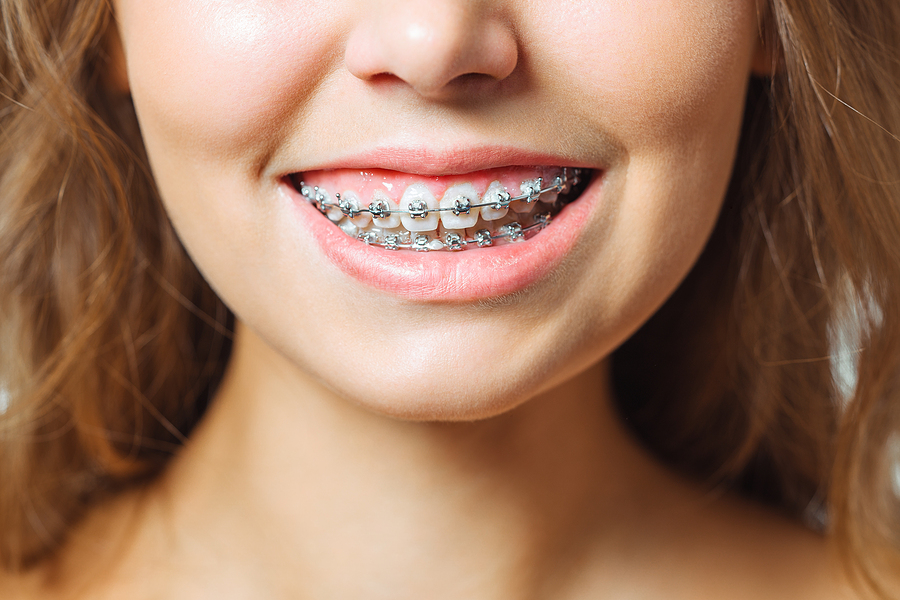While ceramic braces (also known as clear braces) are used to correct lower and upper teeth alignments, and although they do share some similarities with metal braces, there are some key differences that separate the two.
If you are considering getting ceramic braces or have been told by your dentist or orthodontist that you require them, the information below will educate you on all you need to know about ceramic braces.
What is the main difference between ceramic and metal braces?

The main difference between ceramic and metal braces comes down to aesthetics and the speed that results are obtained, despite both being known as “fixed braces”.
Ceramic braces use clear, plastic brackets and wires to straighten your teeth. Some dentists may also offer coloured ceramic braces, which are most popular among young children and adults. A major benefit of ceramic braces in contrast to metal braces is they’re able to blend in with your natural tooth colour and they’re less likely to cause irritation to the gums.
Metal braces, on the other hand, see the brackets glued to your teeth using a safe, specialised dental cement. The brackets are then bound by thin metal wires and in some cases rubber bands (this depends on the severity of your case).
Metal braces have been used in dentistry for over 100 years and have gone through extensive changes to improve their effectiveness. They are the preferred method for almost any dental problem, whether you require minor or serious alignment. The disadvantage of metal braces is that they’re not very discreet, if you have metal braces, it will be obvious in contrast to ceramic braces or plastic aligners. They are also far less likely to stain when compared to ceramic braces due to their metal-based properties.
Both brace types are available for children and adults, all that’s required is a consultation with your dentist.
How much do ceramic braces cost?
In the UK, the average price for ceramic braces is between £1,500 to £4,000, depending on several factors. At Hove Dental Clinic, ceramic brace treatments start at £2,000. For more information, visit our price plan page.
The advantages of ceramic braces
There are some distinct advantages of ceramic braces that make them a strong choice for patients of all ages:
- They can use tooth-coloured brackets and white wires to be discreet
- They work faster than plastic aligners, such as Smilelign and Invisalign
- You get to choose what colour your braces are (ideal for young children and teenagers)
- They are less invasive than metal braces
The disadvantages of ceramic braces
- They are more expensive than traditional braces
- The brackets are larger, which can sometimes cause gum sensitivity (this varies from patient to patient and can often be fixed through minor orthodontic treatment/tweaking)
- Results are slightly slower than traditional metal braces
- They are more likely to stain than metal braces
Are ceramic braces right for me?

Ceramic braces are typically a very good option for most patients looking for teeth straightening solutions. Until you book an appointment with your dentist, you won’t know if you’re a candidate for ceramic braces. If your problem is very minor, you may even be a candidate for clear aligners, such as Smilelign.
There are pros and cons to both metal and ceramic braces, it simply depends on your personal preference and the advice of your dentist.
Straighten your smile with ceramic braces from Hove Dental Clinic
Booking a consultation with our team will help you understand more about ceramic braces and whether you’re an appropriate candidate. Every patient is different and requires a personal consultation with our Principal Dentist to discover what treatment plan is most beneficial. You will be given a quote and approximate time frame on how long you will wear your ceramic braces.
Book your consultation for ceramic braces today and begin your journey to a brighter, straighter smile.
FAQs:
How long do ceramic braces take to work?
Every patient is different and it is very difficult to determine how long ceramic braves will take to work without booking an appointment. In contrast to metal braces, ceramic braces can take from approximately 6 months longer to straighten teeth. Again, this varies from patient to patient.
What happens if ceramic braces stain?
Even if you follow a good diet, it’s not uncommon for ceramic braces to stain. However, they can be cleaned by simply brushing the stains out of your teeth. If the stains do not disappear after thorough cleaning, visit your dentist as they will be able to professionally clean and remove stain marks.
Can I get my teeth whitened while wearing ceramic braces?
No, teeth whitening is not possible while wearing ceramic or metal braces.
Can I get ceramic braces if I have porcelain veneers?
Yes, even if you have porcelain veneers, you will still be able to get braces, providing they are not attached directly to your veneer. However, the more porcelain veneers you have, the trickier it becomes to apply braces, as they typically have trouble bonding to porcelain veneers.




















